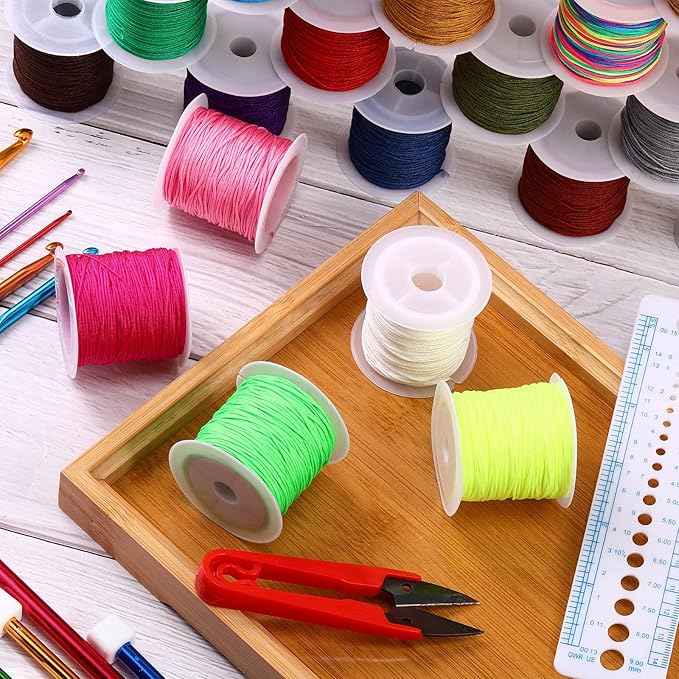What is Nylon Thread?
Nylon thread is created by twisting nylon yarns together at high speed. It is primarily used for leather sewing in industries such as footwear, bags, and sofas. Nylon thread is the most common type of leather sewing thread and is also widely used in fishing rods.
In Taiwan fishing, nylon thread is the most frequently used. The chemical composition of nylon is PA, a petroleum by-product similar to PE. Unlike PE, nylon thread is typically single-stranded. One of its main advantages is its elasticity, which makes it less likely to break during casting and fishing. Nylon thread is also cost-effective due to nearly 70 years of technological development, making it cheaper than PE thread. Additionally, its smooth surface reduces wear on fishing rod loops.
However, nylon’s elasticity can also be a drawback. When fish give subtle signals, the nylon thread may not transmit these signals quickly enough, causing missed opportunities. Also, under the same tension, nylon thread is thicker than PE thread, which can reduce the casting distance when using lures.
What is PE Thread?
PE thread is a fishing line made by braiding multiple strands of chemical fibers, then dipping them in glue. It is often referred to as braided line. The first brand to introduce this was “Dali Ma.”
The production of PE thread involves weaving microfibers such as Dacron, Kung Fu Dragon, or PE fibers from polyethylene compounds. This results in a fishing line with a regular crossing fiber pattern, easily visible upon inspection.
PE thread’s advantage lies in its thin diameter compared to nylon of the same tension. For example, 12-pound PE thread is thinner and casts farther than 12-pound nylon. In windy conditions, PE thread’s thin diameter helps reduce wind resistance, improving casting distance. PE thread also has little to no elasticity, allowing for immediate signal transmission when a fish bites. Additionally, it is more wear-resistant than nylon.
However, PE thread’s lack of elasticity can lead to issues such as lost fish. Unlike nylon, which provides some flexibility during a fish fight, PE’s rigid nature can make it easier for fish to unhook themselves. Some manufacturers enhance PE’s tensile strength by adding metal wire, but this further reduces the thread’s elasticity and softness, and increases wear on the guide rings.
What is Carbon Wire?
Carbon wire is made from resin containing fluorine and carbon. It offers quick water-cutting capabilities and has a low refractive index, making it almost invisible underwater. It does not absorb water and has stronger UV resistance and durability than nylon wire. Due to its low elasticity and high density, carbon wire allows bait to reach desired depths quickly while providing good sensitivity.
The almost zero refractive index of carbon wire reduces fish sensitivity, allowing them to bite more confidently. Carbon wire is ideal for soft bait rigs, such as lead-free rigs, Wacky rigs, and Texas rigs, but it is not suitable for hard baits or surface lures.
However, carbon wire has some disadvantages. It has relatively weak knot strength and is stiff. If used as the main line, it is recommended not to exceed 10 pounds on a spinning reel or 20 pounds on a baitcasting reel. Carbon wire can also be used as a leader line due to its superior wear resistance, often paired with PE line to offset PE’s lack of durability.
Differences Between Nylon, PE, and Carbon Thread
- Material
- Nylon thread is made of twisted nylon yarns.
- PE thread is a braided fishing line made from chemical fibers and dipped in glue.
- Carbon wire is produced from resin containing fluorine and carbon.
- Properties
- Nylon thread offers slower response times and stable performance. It can balance well with water weight.
- PE thread floats and has no specific gravity in water. Anglers using strong lines, like 80-100 pound PE, often use it for heavy fishing techniques.
- Carbon wire has a specific gravity of 1:1.7, sinking faster than nylon. It is ideal for bottom fishing techniques like Texas rigs or silicone lead hooks.
- Elasticity
- Nylon thread is elastic, making it easier to handle but slower to transmit signals. This elasticity can make the signal more stable.
- PE thread has very low elasticity, providing high sensitivity and immediate response but increasing the risk of losing fish.
- Carbon wire shares PE’s low elasticity, with high wear resistance.
- Strands
- Nylon thread is typically single-stranded and differs significantly from the multi-stranded, braided structure of PE thread.
- Carbon wire doesn’t have a specified strand structure, as it’s made from fluorine and carbon resin rather than woven fibers.

